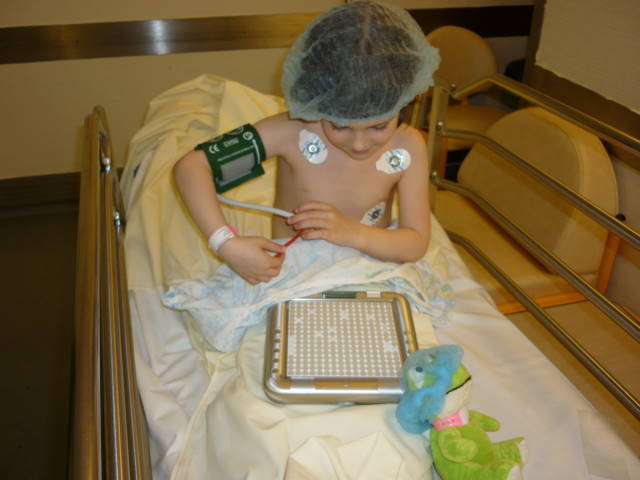| :: Home :: Editor: Associate Editor: ISSN 1715-3956 |
|
Disclaimer: |
Vol. 14 No. 3 |
December 2012 |
Commentary
Ideas for improving preoperative preparation of children for anesthesia: Winners of a competition in France
Françoise Galland
SPARADRAP, a nonprofit organization based in Paris, France, was founded in 1993 with the objectives of improving management of pain in children, better preparing children for health care interventions, and more fully involving family and friends when children are sick and hospitalized.
Despite the improvement of technical methods and safety, anesthesia remains a cause of major concern for children and parents. These legitimate fears and pain can be significantly reduced when a project to better welcome and prepare children is established by departments of anesthesia. To encourage these initiatives and promote their development, SPARADRAP launched a national competition in 2011 for teams from the anesthesia departments of hospitals in France.
SPARADRAP received 13 eligible applications from institutions ranging from academic tertiary care hospitals to primary care hospitals. The multidisciplinary jury comprised professionals from anesthesiology (nurse and physician), psychology, and sociology. The jury paid special attention to methods that promote the following: provision of information to child and families, well-being and comfort, separation from parents, assessment and relief of pain, and parental presence postoperatively. The team approach, the introduction of protocols, and a process of evaluation and sustainability were also part of the selection criteria.
The winners of the contest were notified in September, 2012 (http://tinyurl.com/prix-du-concours), and they were awarded certificates depicting gold, silver and bronze anesthesia masks (Table 1). This competition revealed the inventiveness and effort of some units in taking care of children undergoing surgery and in ensuring that the operating room was no longer a closed and frightening place.
Table 1
Award winners
Golden Mask (4,000 €) In this project entitled “No fear no pain”, the information provided to children and parents is pivotal. The pre-anesthesia consultation involves three stages: the anesthesiologist gives medical information, a specialist child nurse gives practical information and the nurse anesthetist gives information through the use of games (e.g. Playmobil®, customized dolls). To alleviate the separation from parents but also reward the child, many tools have been developed around a mascot (Hugo). |
Silver mask (3,500 €) The project is based on a simple original idea. During the pre-anesthesia consultation, the child is given an anesthesia mask and stickers to decorate at home and bring it the day of surgery. He is also asked to choose a favorite story that will facilitate distraction or hypnosis for anesthesia induction in the operating room. |
Bronze mask (3,000 €) The information and preparation of children and parents are individualized with a specific nurse consultation. The team created a book explaining the surgical path mixing ward photos and fun pictures. The book contains no text, which allows each caregiver to adapt his or her language and the type of information given, depending on the age of the child. To promote the familiarity of the child with medical equipment, the team explains and gives the child a cap, mask, stickers, and similar items. |
Examples of other actions:
- To inform and prepare children for anesthesia, hospitals provide consultation with a nurse in addition to the statutory consultation with the anesthesiologist.
- To link hospital and home: donation of medical equipment (e.g. anesthesia mask, surgical mob-cap); allowing parents to fill a small box provided to children with symbolic “kisses” (e.g. lipstick on pieces of paper, written notes) which the child can carry into the operating theater. Boxes are given to the hospital by a local company.
- To encourage children’s participation and reduce their feeling of helplessness: letting them choose the scent of the mask or customize the mask with stickers.
- To allow children to sit during the induction of anesthesia.
- To minimize the time of separation from parents before induction, development of transfer rooms close to the operating room. All monitoring leads are placed in the transfer room with the assistance of parents, and the total time between separation from parents and induction is reduced to about two minutes (see Figure 1 and http://tinyurl.com/rolling-induction).
- To distract the child awaiting surgery, encouraging interventions of volunteers in the transfer room, providing games, digital tablets, or training staff to use hypnosis.
As an additional positive aspect, this competition showed us the heterogeneity of practices between the anesthesiology teams, in particular with respect to:
- Preoperative fasting: some units provide instructions to maintain fasting 6 hours before surgery, while others allow the child to drink a clear liquid up to 2 hours before surgery, regardless of the child’s age (Smith et al., 2011).
- Parental presence during induction and in recovery rooms: This practice is often desired by families (Galland et al., 2006). It is still very rare in France to have parents present at induction (only 1 candidate) but it is more frequent in the recovery room (8 out of 13 candidates).
To encourage new initiatives, complete records of winners (photos, films, protocols) are displayed on the website: www.sparadrap.org, “Professionals” area, “Initiatives” section.
Figure 1. This photograph, provided by Necker hospital, Paris, Pediatric ambulatory surgical service, illustrates the use of sitting position, distraction with a novel musical device, and preparation of monitoring leads in the transfer room before separation from parents.
Françoise Galland |
Cite as: Galland F. Ideas for improving preoperative preparation of children for anesthesia: Winners of a competition in France. Pediatric Pain Letter 2012;14:44-46. www.childpain.org/ppl
Acknowledgments
The author appreciates the contributions of Dr. Chantal Wood, Alexandra Beck, Malka Jakubowicz, Myriam Blidi, and Dr. Daniel Annequin.
References
Galland F, Cohen Salmon D, Devoldere C, Cellier E, Annequin D. Enquête nationale de l’association SPARADRAP sur la place des parents à l’hôpital. Arch Pédiatr 2006;13:877.
Smith I, Kranke P, Murat I, Smith A, O’Sullivan G, Søreide E, et al. Preoperative fasting in adults and children: guidelines from the European Society of Anaesthesiology. Eur J Anaesthesiol 2011;28:556-569. PubMed Abstract


